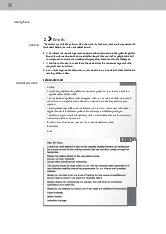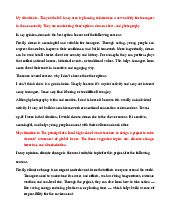

Preview text:
lOMoAR cPSD| 59561451 FINAL TEST Code: ZFT.0324.FIA Name: Reading Module
Read the text and answer the questions 1-6. Apes and the Common Cold
A mysterious illness swept through a community of chimpanzees in Uganda's Kibale National Park, resulting in coughing,
sneezing, and even fatalities. A veterinarian named Tony Goldberg seized a rare opportunity to investigate the cause when
a chimp named Stella was found freshly dead.
After conducting a thorough necropsy, Goldberg found signs of pneumonia in Stella. Later tests revealed an unexpected
suspect: human metapneumovirus (HMPV), a common cold virus in humans. Unfortunately, over 12% of Stella's chimp
community died in the outbreak, including her own baby.
This phenomenon, known as reverse zoonosis, refers to the occurrence wherein animals acquire diseases from humans.
Great apes are especially vulnerable due to their genetic similarity to humans. In fact, certain ape populations face a
greater danger from these diseases compared to the threats of habitat loss or poaching.
This poses a dilemma for conservationists. Ecotourism plays a crucial role in safeguarding ape habitats and providing
support to local communities. However, it is important to note that this form of tourism also brings humans into close
contact with the animals, which can potentially heighten the risk of disease transmission. While some guidelines exist to
minimize this risk, they are not always followed, and even careful tourists can unknowingly carry pathogens.
Researchers like Goldberg are searching for solutions. One promising approach focuses on the source of these
pathogens: local children. Research has shown that common cold viruses tend to spread among children, who then infect
adults working in the forest or interacting with tourists. These adults, who may not show any symptoms, can then
unknowingly transmit the viruses to the apes.
The solution, Goldberg suggests, lies in improving the health of children living near great apes. This could involve teaching
hygiene practices and providing healthcare resources to these communities. Additionally, enforcing existing biosecurity
rules and supporting responsible tourism practices can help minimize the risk of transmission.
Eliminating common cold viruses is not currently possible, but scientists are optimistic that by gaining a deeper
understanding of the issue and implementing preventive measures, they can decrease the frequency and severity of these
outbreaks. This will contribute to the protection of both the giant apes and the humans with whom they coexist. Choose the correct answer. lOMoAR cPSD| 59561451
1. What does the passage mainly discuss?
A. The benefits of ecotourism for ape habitats and local communities.
B. The importance of controlling human-ape interactions.
C. The threat of poaching to great ape populations.
D. The spread of a human cold virus among chimpanzees.
E. The development of a treatment for diseases affecting chimpanzees.
2. What was the main reason Stella died?
A. chimpanzee pneumonia
B. a bacteria infection C. dirty food or water D. a human cold virus E. habitat loss
3. Great apes are more likely to get diseases from humans because theyA. often come into close contact with tourists.
B. share many genetic similarities with humans.
C. are exposed to viruses from local children.
D. have less access to medical care.
E. live in ecotourist-friendly areas.
4. According to the fourth paragraph, the challenge that conservationists are facing is ...
A. how to balance the economic benefits of ecotourism with the health risks it poses to apes.
B. how to develop vaccines to protect apes from human diseases.
C. how to instruct tourists to keep the proper distance with apes.
D. how to deal with tourists who do not follow the guidelines when seeing apes.
E. how to find alternative income sources for local communities reliant on ecotourism.
5. Which of the following best reflects Goldberg's proposed solution to the zoonosis in apes?A.
Supporting tourism practices that prioritize the well-being of ape populations.
B. Conducting more studies to better understand zoonotic diseases.
C. Promoting healthier lifestyles among children living near ape habitats.
D. Implementing stricter quarantine measures for tourists visiting ape habitats.
E. Relocating ape populations to areas with less human contact.
6. According to the last paragraph, what are the chances of getting rid of all common cold viruses?A. It will happen soon.
B. It is not possible at this time.
C. It is possible with enough financing.
D. It depends on the development of a vaccine.
E. Researchers give it a lot of attention now.



